Newsletter: The Virginia Museum of Fine Art’s ‘Dirty South’ revels in Black Southern culture
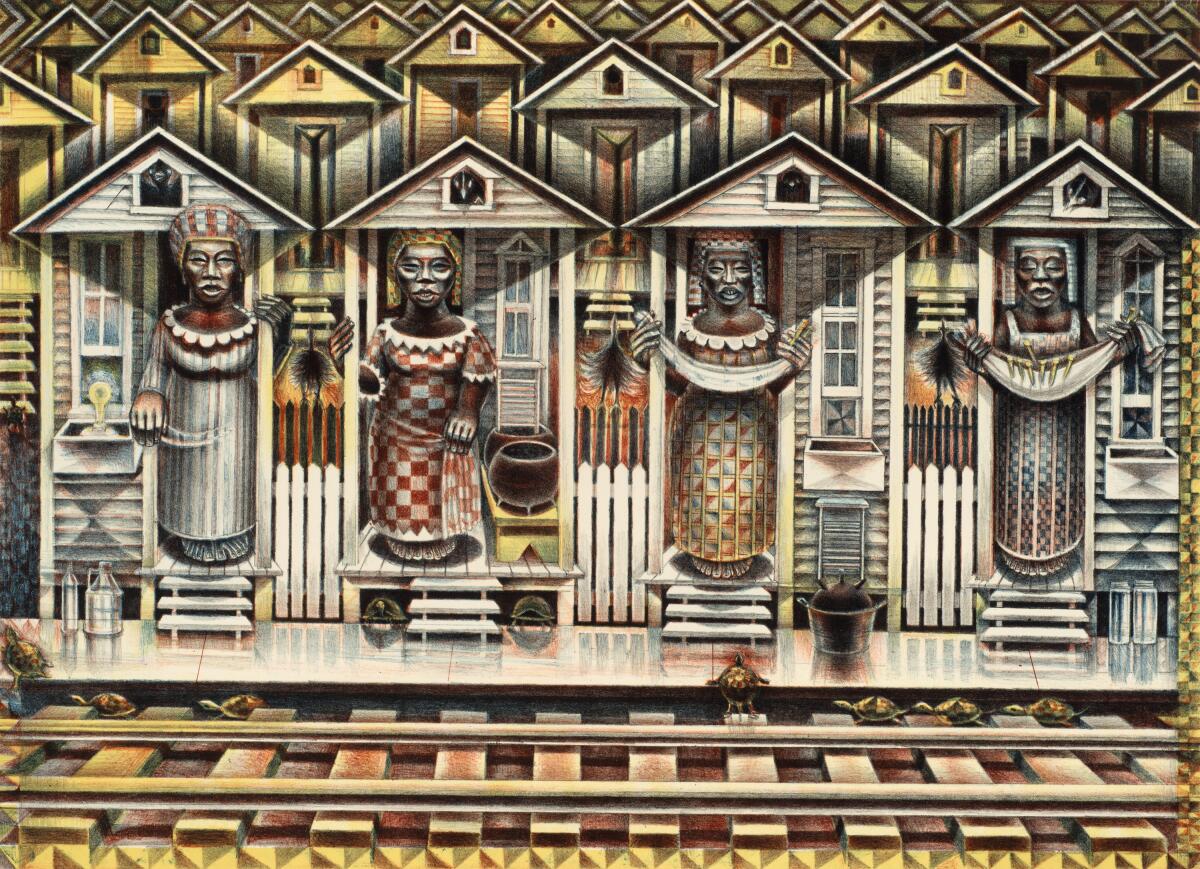
Did somebody say “Cheese Trail?” Well, I’m here for it. I’m Carolina A. Miranda, arts and urban design columnist for the Los Angeles Times, and I’m here with the week’s essential arts news and more art reports cultivated during my cross-country drive — because what’s the point of writing a newsletter if you can’t foist your vacation photos on everyone?
‘Dirty South’ is revelatory
Is it too early, in the month of August, to start compiling one of those year-end “best” lists? No, you say? Well, good. Because No. 1 on my working list at the moment is a powerful and engrossing group show in Richmond, Va. “The Dirty South: Contemporary Art, Material Culture, and the Sonic Impulse,” on view at the Virginia Museum of Fine Arts through early September, is a tour de force. Or, more accurately, a tour de South. And it will leave you wanting more.
Organized by the VMFA’s curator of modern and contemporary art, Valerie Cassel Oliver, the exhibition charts the ways in which Black artists have drawn from Southern tradition in the creation of art, music, design and the countless hybrid spaces in between.
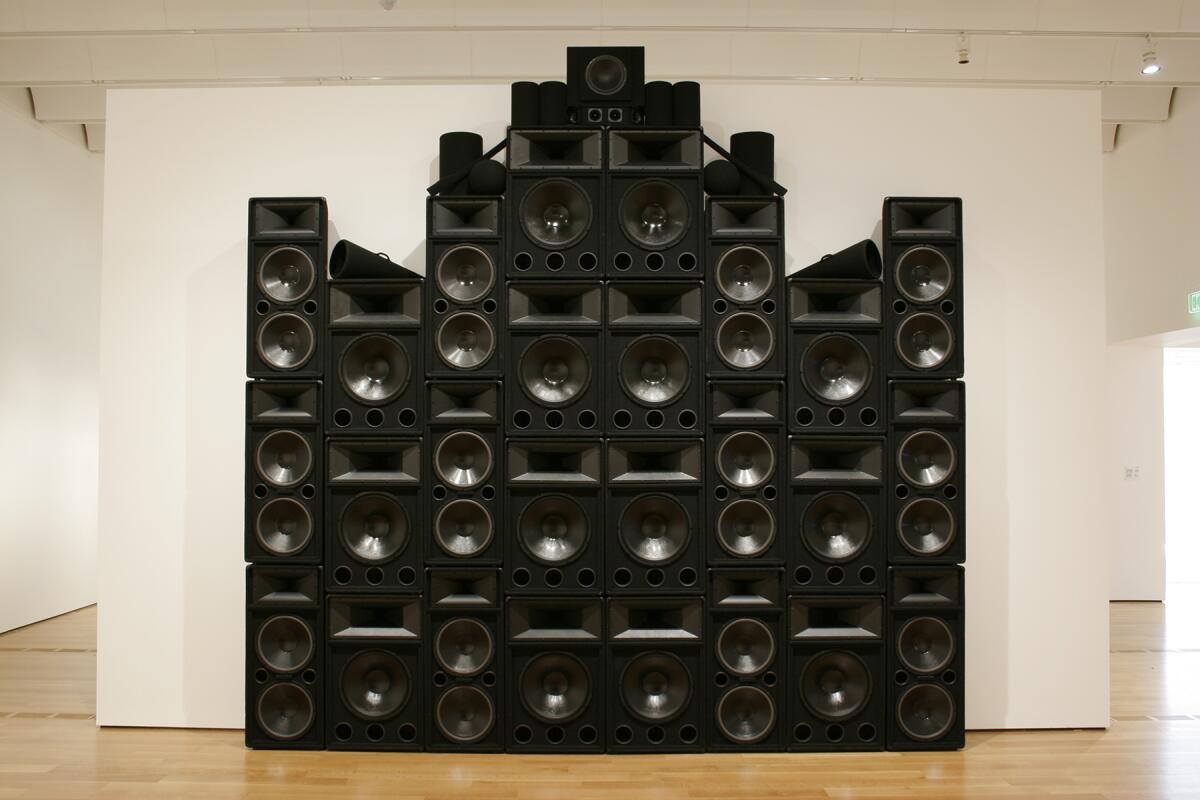
It’s a show about the art that has emerged from a region that is also about so much more. It’s a show about the ways in which different forms have reacted and engaged with one another — how landscape materializes in art, how Black bodies materialize in those landscapes, how spirituality materializes in culture, how music permeates it all and how all of it has informed American culture.
The exhibition goes back a century — with works, such as a watercolor by Aaron Douglas, that date to the 1920s — drawing from the region’s rich cultural history. This includes folk art, vernacular architecture and music. The point, says Cassel Oliver, is to look at art “not necessarily through a Western sensibility, but a Southern sensibility.”
This includes, for example, a three-dimensional geometric wall piece by contemporary artist Sanford Biggers that employs an antique quilt as its source material. (Biggers is currently the subject of a solo exhibition at the California African American Museum in Los Angeles, where he is displaying work from that series.)
But if the show draws from history, it isn’t mired by it. “There is this whole generation of artists who are reframing how we look at the South,” Cassel Oliver tells me. “It’s not just civil rights and the struggle. They are reframing the South as a new place of the future.”
Make the most of L.A.
Get our guide to events and happenings in the SoCal arts scene. In your inbox once a week.
You may occasionally receive promotional content from the Los Angeles Times.
And, in fact, “Dirty South” feels more like intense journey than run-of-the-mill museum exhibition. And that journey begins in the lobby of the museum, which features a SLAB — that’s Houston parlance for a lowrider, standing for “Slow, Loud and Bangin’” — a tricked-out Cadillac bearing the license plate “DRTYSTH,” created by hip-hop artist Richard “Fiend” Jones. Get in, it seems to say. You are going on a ride.
Functioning as the exhibition’s principal wayfinders are three sound and video installations that provide visceral jolt and serve as a framework for all of the other work in between. This includes a large-scale installation at the entrance by Paul Stephen Benjamin titled “Summer Breeze” that features a stack of TV monitors playing fragments of Billie Holiday’s “Strange Fruit” spliced with Jill Scott‘s 2015 rendition of the song. The phrase “black bodies swingin’” is endlessly looped and juxtaposed against a visual loop of a little Black girl rocking back and forth in a swing — Black joy and Black pain inextricably intertwined.
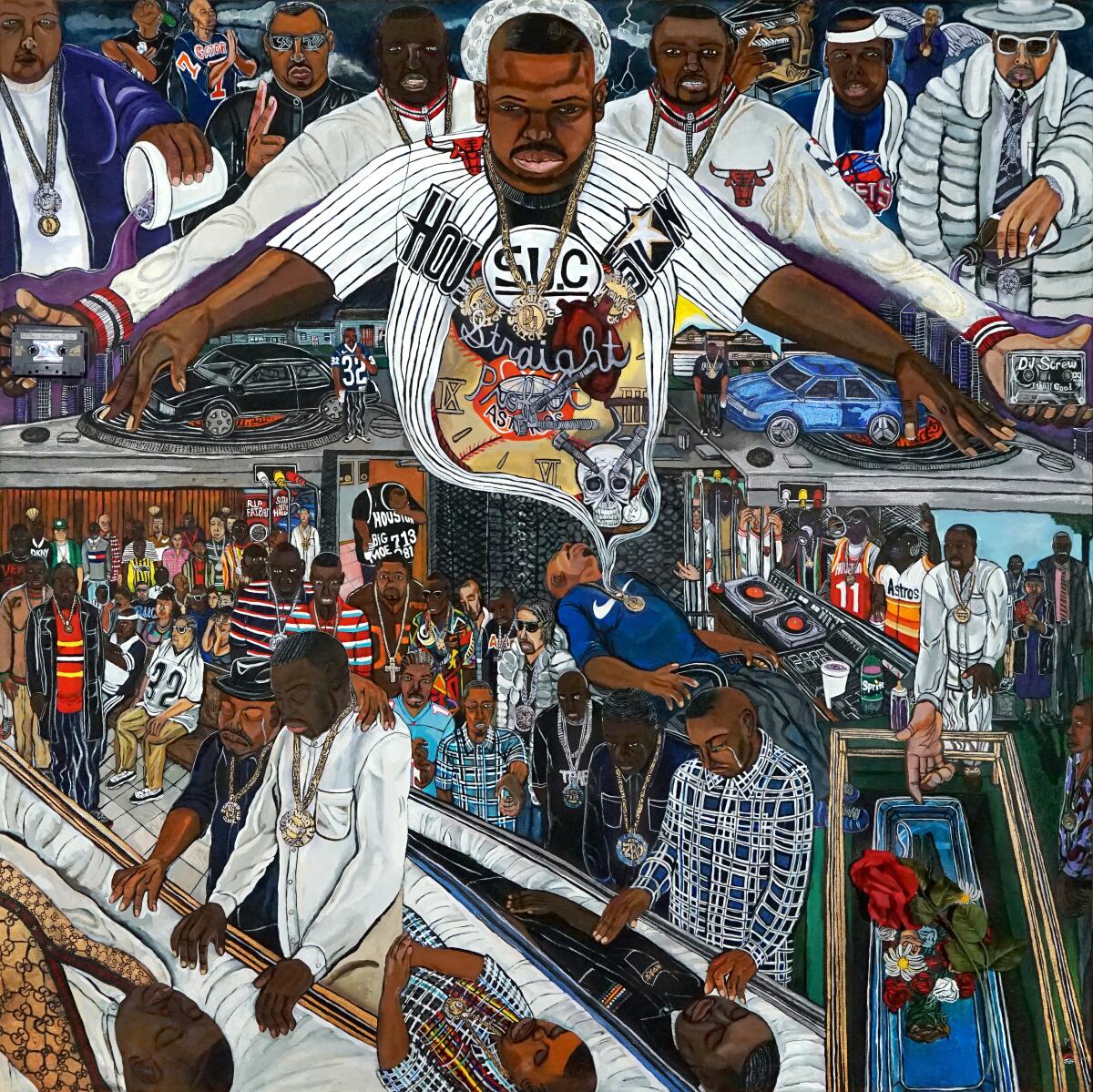
At about the show’s midpoint comes Nadine Robinson’s “Coronation Theme: Organon,” from 2008, which features a stack of amplifiers arranged in a way that evokes the Gothic profile of Ebenezer Baptist Church in Atlanta, where Martin Luther King Jr. once served as a pastor. From it emerges a sonic work that fuses elements of George Frideric Handel’s “Coronation Theme” with “notes” that are crafted from the sound of fire hoses and barking dogs. It is a magnetic combination of the wretched and the angelic.
The exhibition closes with Arthur Jafa’s searing video “Love is the Message, The Message is Death,” which drew widespread acclaim when numerous museums streamed it online last year in the wake of the uprisings. The video, set to Kanye West’s rousing “Ultralight Beam,” weaves together strips of found footage to articulate the traumas and the exhilaration of the Black experience in the U.S. — as if all of the content from the 200-plus pages of Toni Morrison’s “The Black Book” had been compressed into seven minutes of lived experience.
I first saw Jafa’s piece in a group show called “Prisoner of Love” at the MCA Chicago in 2019. I watched it again when it briefly landed online last year. Like many people, I was left stunned by it — grappling with the emotional and historical enormity he manages to deliver with such concision.
Since the piece began to gain a widespread following last year, the artist has expressed a certain wariness about how it is being received. “He himself has had a lot of trepidation about that work because it’s almost a spectacle of pain,” says Cassel Oliver. “Yes there is pain. But there is pleasure. There is an ecstatic that comes out of the spiritual, and the ecstatic that comes out of sex.”
In the context of “The Dirty South,” however, “Love is the Message” is informed by every object that comes before it: the ebullient depiction of a revival meeting, the folk art that infused Modernism, the painting of a blackened nighttime landscape illuminated by a constellation of lightning bugs, the generational struggles of Black people in the United States. In that setting, Jafa’s video feels less like a surprising blow and more like a logical conclusion, in all its terror and its sublimity.
“Dirty South” is a journey. The viewer who goes in will not be the same one who emerges.
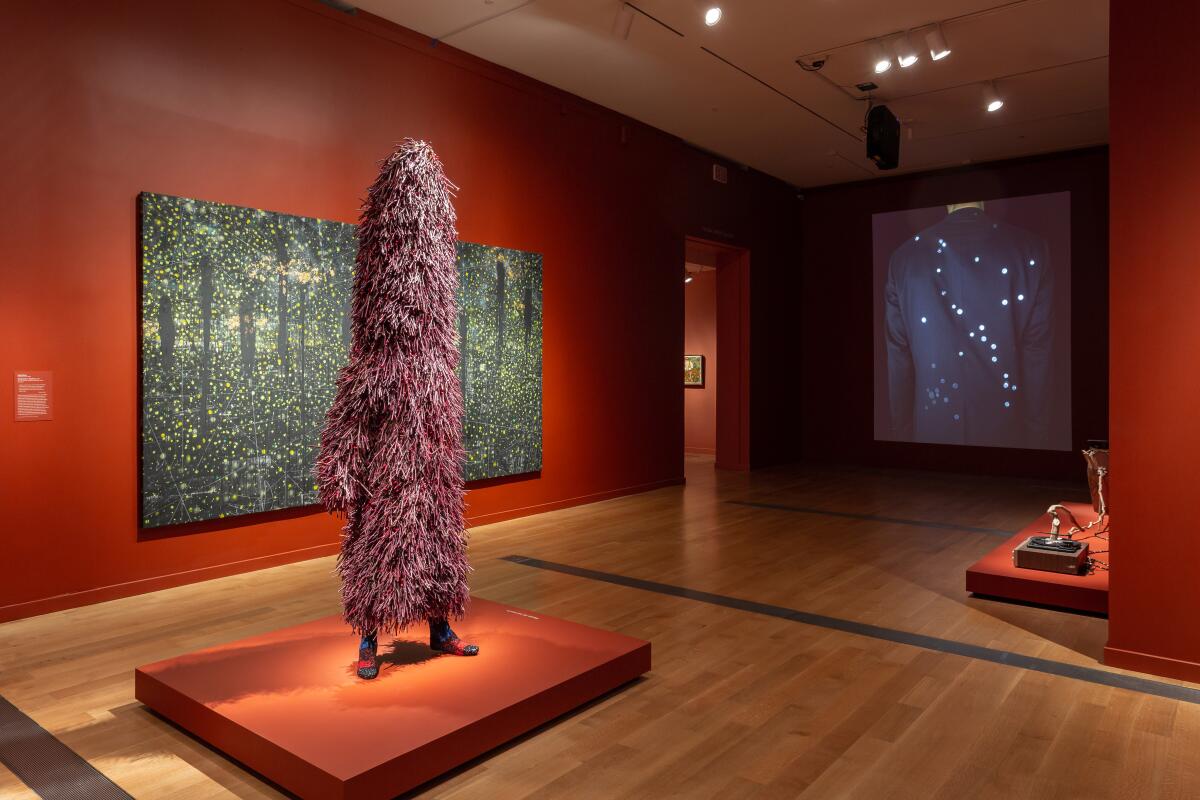
“The Dirty South: Contemporary Art, Material Culture, and the Sonic Impulse,” is on view at the Virginia Museum of Fine Arts through Sept. 6.; find additional information at vmfa.museum. The show is also scheduled to open at the Contemporary Arts Museum in Houston in the fall, after which it will travel to Crystal Bridges in Arkansas and the Museum of Contemporary Art Denver in Colorado. Do not miss.
Art report
The Times’ Jessica Gelt has been immersing herself in the “Immersive Van Gogh” experience so that you don’t have to. (What would Van Gogh do? “Run far away,” she writes, “or at least to the nearest absinthe bar.”) She comes through with a ranking of the merch — the dog bowls and the “Gogh to Sleep Darling” onesie — because the whole point of “Immersive Van Gogh” isn’t simply to selfie, it’s to pick up a thing or two in the gift shop. This is the kind of reporting that merits hazard pay.
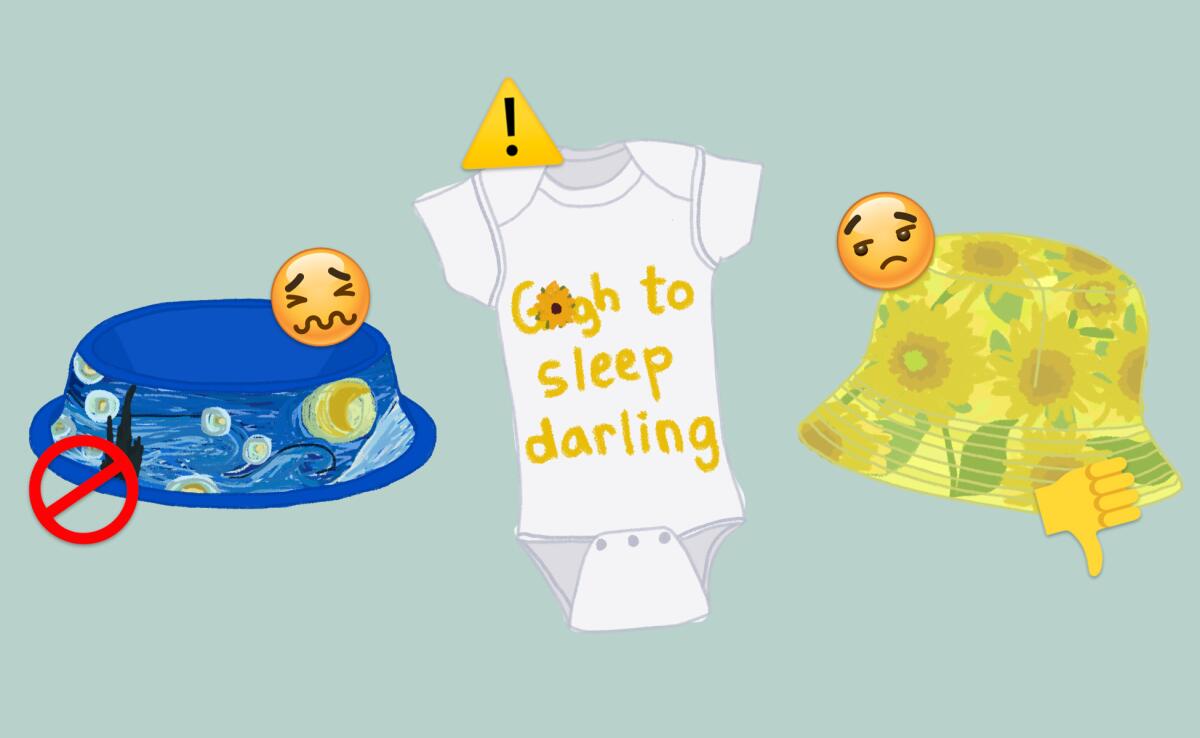
The San Francisco Museum of Modern Art announced last month that it was eliminating a series of divisions, including its film program and its online arts magazine Open Space, in the name of cultivating “a holistic visitor experience that attracts larger, more diverse audiences.” The move has generated opposition and street protests among San Francisco’s arts communities. It’s a strategy, as I write, “that reeks of business consultant-speak.” And it doesn’t “begin to solve the problem at the heart of SFMOMA, which is the museum itself.”
Want some great background reading on SFMOMA and the cultivation of art as asset class? And the ways in which art museums and the finance industry have increasingly become entwined? Then absolutely read this eye-opening piece by reporter Sam Lefebvre.
KQED’s Sarah Hotchkiss offers some necessary alternatives to SFMOMA‘s soon-to-be-defunct film program.
And, five years on, Hotchkiss’ guide to SFMOMA remains the best of the best.
Enjoying this newsletter? Consider subscribing to the Los Angeles Times
Your support helps us deliver the news that matters most. Become a subscriber.
Meanwhile, in Los Angeles: Contributor Jean Trinh writes about the work of artist Stephanie H. Shih, who has her first solo show on view at Stanley’s in Chinatown. The artist uses ceramics to render foods that “feel” Asian even if they have Western origins. This includes tins of Spam, condensed milk and Maggi seasoning. “Culture isn’t static,” says Trinh. “It’s ever moving. And so, with this series, I really wanted to make a statement that these Western products, which we have incorporated into our cuisines, are authentically part of our cultures as well.”
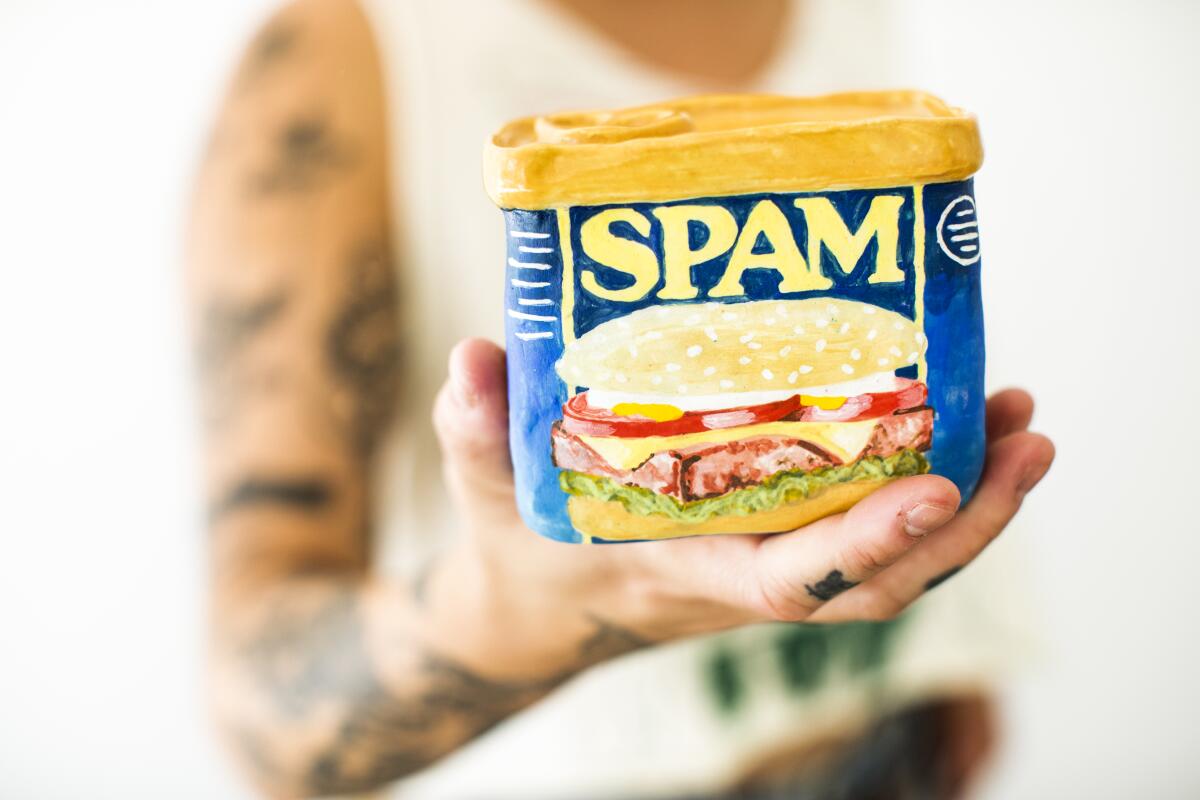
Performance notes
The L.A. Phil staged a chamber music concert at the newly reopened Ford earlier this week that featured work by composers Arvo Pärt and Julius Eastman. Times classical music critic Mark Swed reports that the show, which was conducted by Christopher Rountree, was a beguiling union of opposites. “Pärt offers us an out-of-body experience, whereas Eastman aims gleefully at gut and groin,” he writes in his review. “Pärt’s music is self-control, riveting in its reflection an orderly universe. Eastman is the extreme, riveting opposite.”
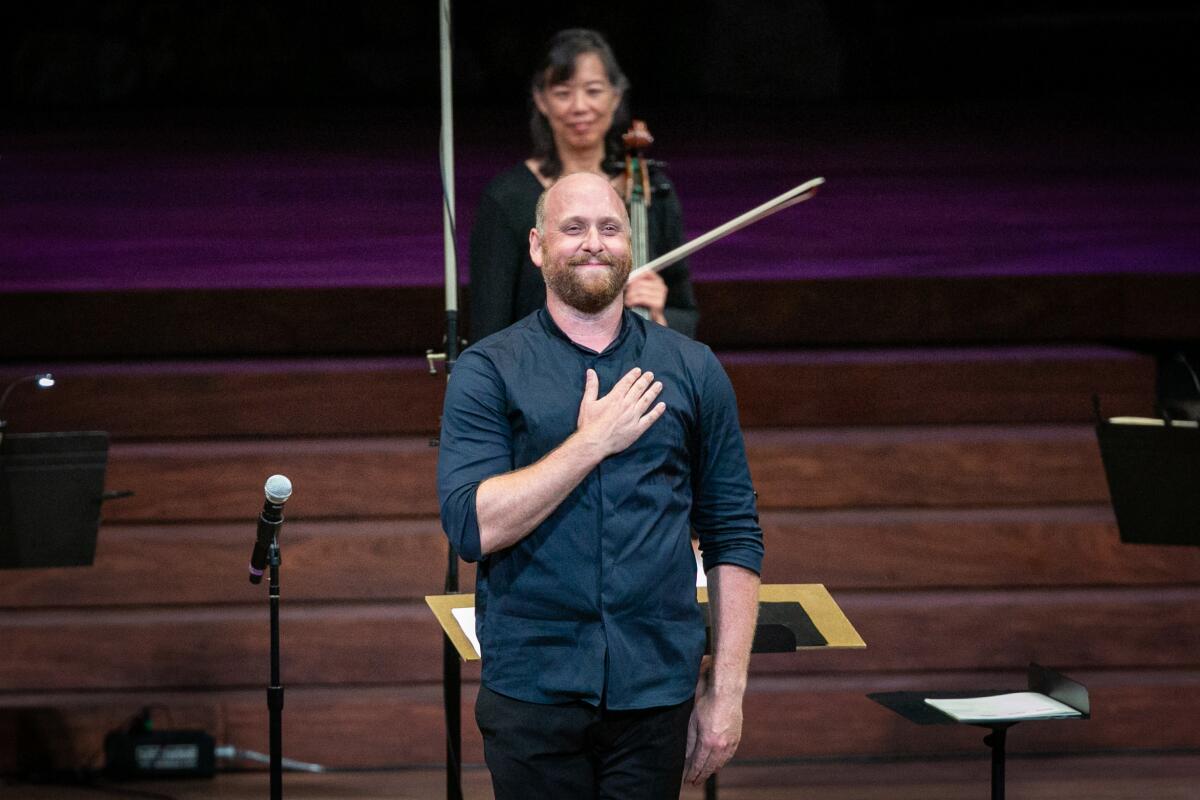
Antoinette Chinonye Nwandu’s “Pass Over,” a play about two Black men confined to the glare of a street light, lest they be killed by police, is the first to be staged on Broadway since the pandemic shuttered New York’s theaters.
The San Francisco Ballet is prepping its first in-person performance, which will take place outdoors at Stanford University. And the San Francisco Opera will demand proof of vaccination for attendees age 12 and over, as will more than a dozen theaters around Washington, D.C.
Michael Tilson Thomas, the L.A.-born conductor who led the San Francisco Symphony for 25 years, is in recovery after a successful surgery to remove a brain tumor.
Design time
The Times’ Roger Vincent writes about the dismantling of the giant fiberglass elephants at Hollywood & Highland, part of a $100 million makeover of the mall where the Oscars are held. The design had been inspired by the Babylonian-style set D.W. Griffith employed in his 1916 movie “Intolerance.” Part of the makeover is intended to attract more locals to the spot — but also to eliminate the visible tributes to a director with a wildly racist legacy.
Last year, Curbed’s Alissa Walker went in deep on the fraught significance of the architecture.
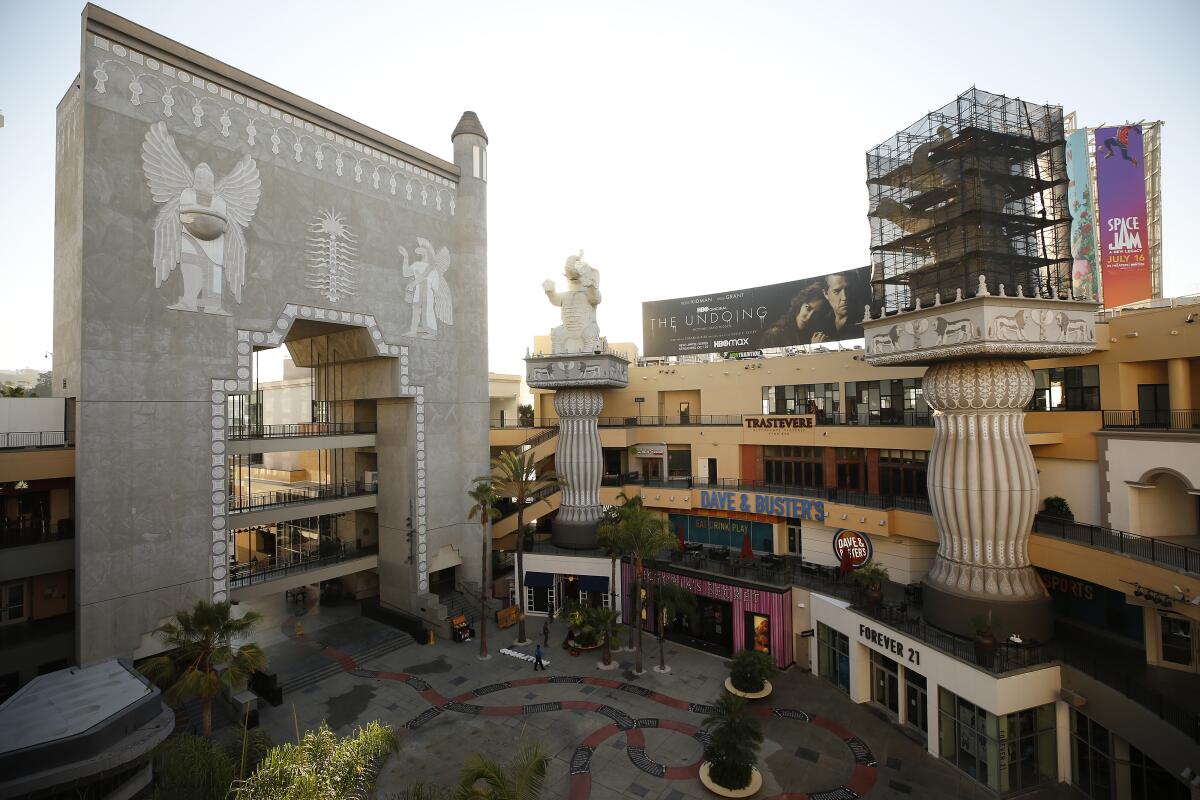
“If you’re dressed correctly and carry a clipboard around, you can get away with a lot of stuff.” L.A. artist Richard Ankrom reminisces with the LAnd Magazine about that time he made a fake freeway sign to correct a real problem around a poorly marked interchange on the northbound 110. The piece, titled “Guerrilla Public Service,” lives on in L.A. lore. Whatever you do, don’t miss Ankrom’s video, a key part of the work.
Essential happenings
If you’ve been counting the minutes to the weekend, Matt Cooper will make sure that you don’t run out of things to do. This includes a rack of cultural happenings, including a night of Tchaikovsky at the Hollywood Bowl — complete with fireworks. He also rounds up all that is doing in L.A. and O.C.’s museums, including a new installation of work by Brian Jungen at the Hammer Museum. The artist often repurposes commercial goods — think: sneakers and softballs — into pieces that comment on Indigenous tradition and colonialist legacies.
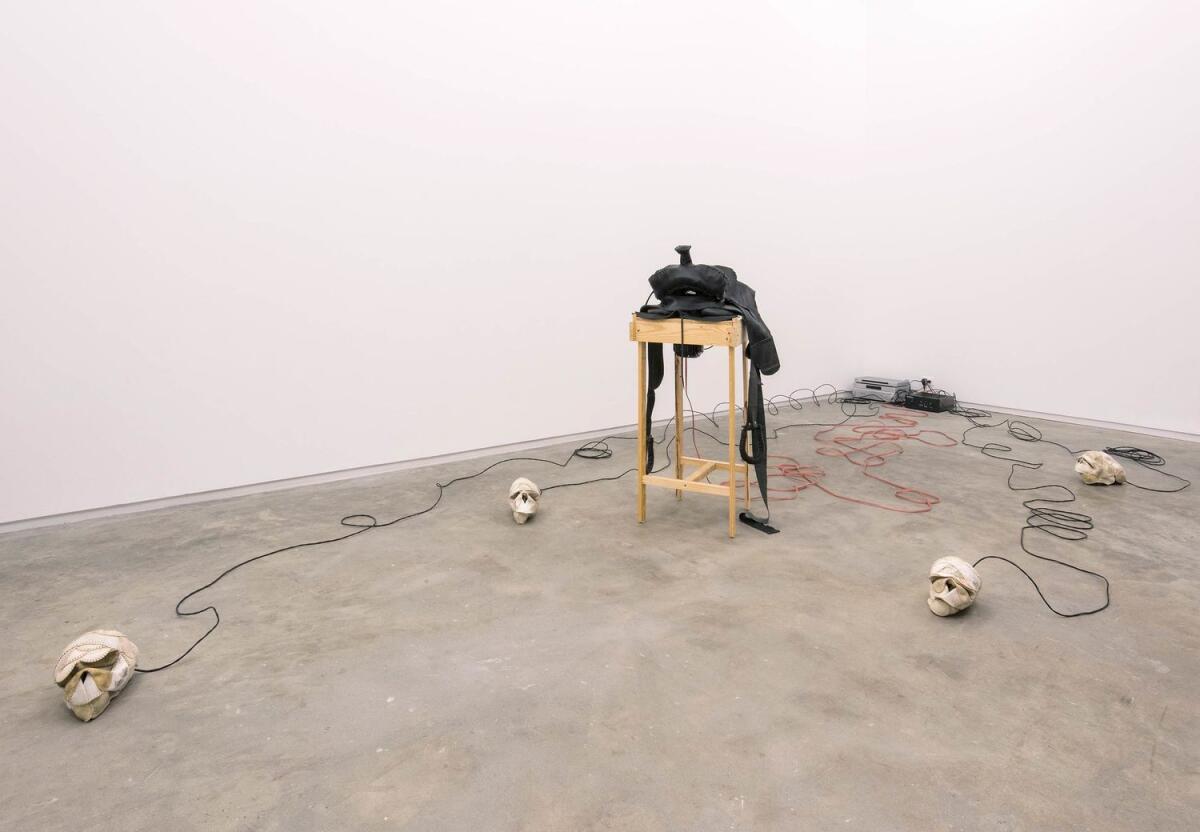
On my recent cross-country jaunt, I caught an exhibition by Marie Watt and Cannupa Hanska Luger at the Denver Art Museum. “Each/Other,” as the show is titled, features work by the two Indigenous artists, who are known for their collaborative practices. You may recognize Luger’s name because I wrote about his show, “Passage,” at the Mesa Contemporary Arts Museum in Arizona in last week’s newsletter (now in its final weekend). Luger was also codirector of “Sweet Land,” the experimental opera staged by the Industry in the Los Angeles State Historic Park early last year — where, in addition to helping oversee the production, he also designed the costumes.
“Each/Other” features some of those costume designs in its galleries, as well other pieces that are born of collaboration. This includes a piece, made with Watt, that consists of a large-scale figure of a canine — a companion species — that has been quilted together out of stitched bandanas submitted by hundreds of contributors.
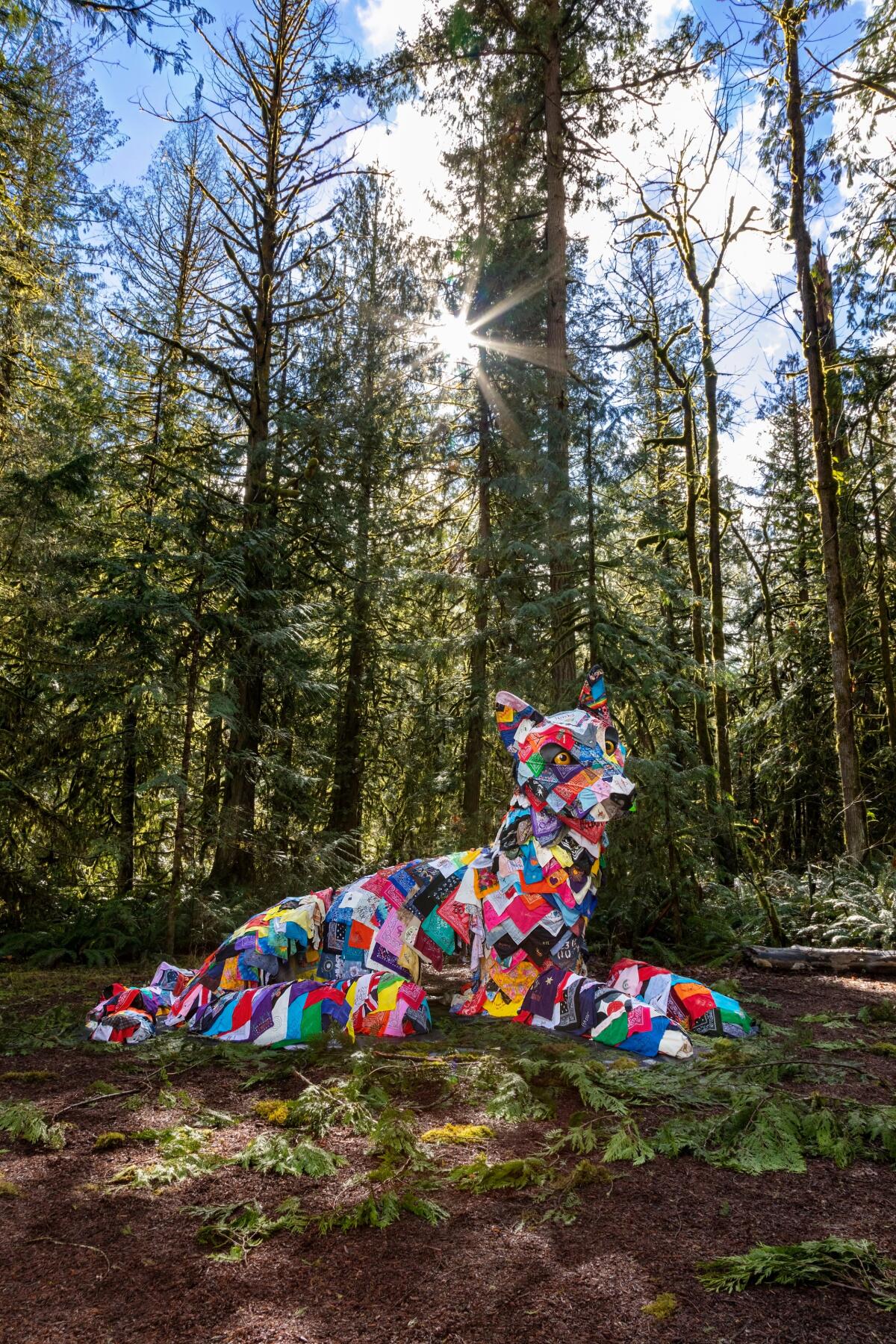
I was especially intrigued by the arquitectonic ways Watt works with textiles such as blankets, an object freighted with so much historic and personal symbolism. This included a 2016 sculpture, “Blanket Stories: Talking Stick, Works Progress, Steward (White Pine),” a slender, vertical wooden piece, almost minimalist in nature, that evokes an impossible tower of folded blankets. Another piece, “Skywalker/Skycraper (Babel),” 2012, features actual blankets, pierced by a steel I beam, that nod to the Indigenous workers who helped build Manhattan’s skyscrapers.
In Watt’s collaborative patchwork quilts, the myriad voices of the sewing circles that help produce them come to life — literally, in the form of words and phrases that have been stitched onto the surface of the piece by individual contributors. A quilt devoted to trees contains poetic expressions like “invisible ancestors” and “monsoon clouds.”
We may feel like we’re falling apart, but in these works you find evidence of the small but potent ways in which we come together.
“Each/Other: Marie Watt and Cannupa Hanska Luger” is on view at the Denver Art Museum in Denver, Colo., through Aug. 22; denverartmuseum.org. Missed it? “Each/Other” will travel to the Michael C. Carlos Museum at Emory University in Atlanta in the fall, followed by a showing next year at the Peabody Essex Museum in Salem, Mass.
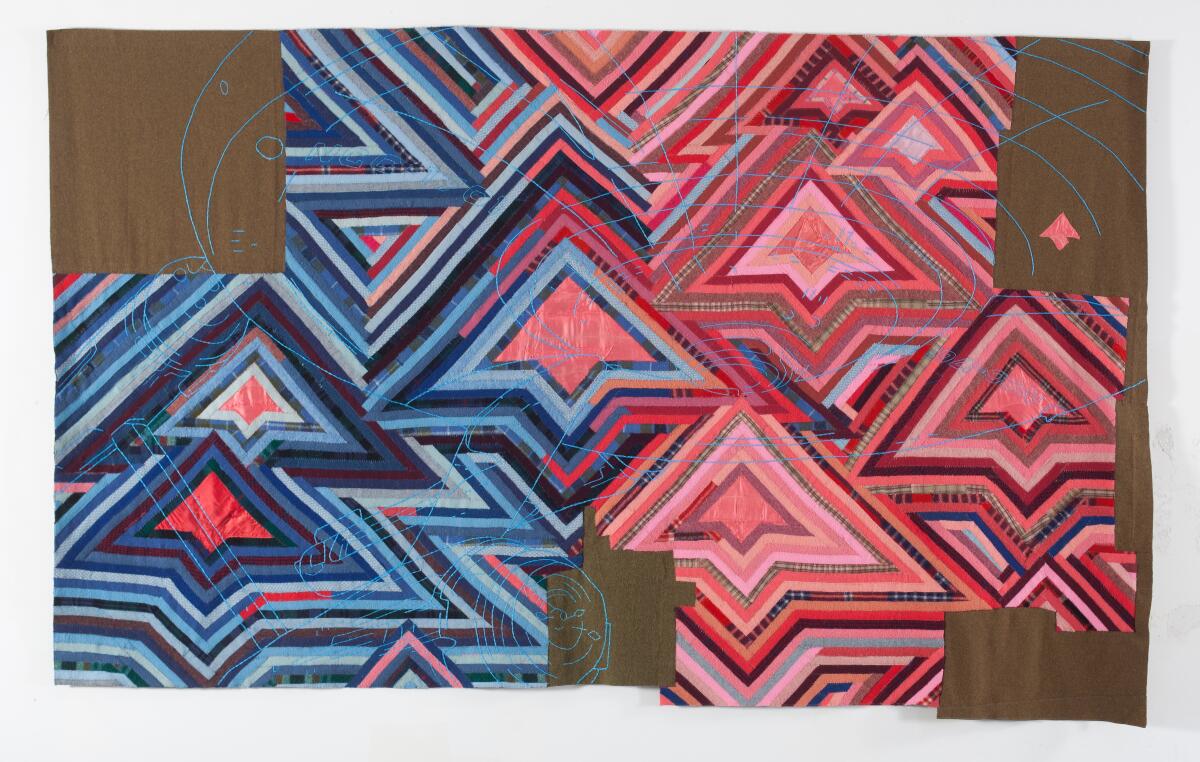
Because everything seems to be happening at once: The Getty is organizing a virtual public reading of Book 12 of the Florentine Codex — about how the Spanish took Mexico City — that will go down all day next Friday. You can sign up to be a reader, or you can simply watch. Get all the deets here. (ICYMI: I wrote about the significance of this colonial codex to our plague-ridden era last year. )
Passages
Louise Fishman, a painter who put a feminist, lesbian and Jewish spin on Abstract Expressionist painting, is dead at 82.
In other news
— When it comes interior design, it appears that less is now a bore. Thank. God.
— The Met’s Alice Neel retrospective is coming to the West Coast. It will land at San Francisco’s de Young Museum in March.
— Speaking of the Met: The museum’s guards there say that the reopening has been a strain.
— Meanwhile, in Los Angeles ... William Poundstone parses MOCA’s new acquisitions.
— In constructing its new Peter Zumthor-designed building, LACMA has been turning up bones.
— Writer Jody Zellen has a look at how artist Vera Lutter created the surreal pinhole images of the demolished LACMA buildings currently on display at the museum.
— Ela Bittencourt catalogs the damage that fire has wreaked on Brazil’s Cinemateca.
— The New York Times has a good story on the squabble between the heirs of artist Harvey Fite and the foundation that maintains his unusual work of land art, “Opus 40.” It involves a terrible fence.
— Hiroshi Sugimoto is set to give the Hirshhorn’s sculpture garden a makeover in Washington, D.C.
— Can we please get some mushroom-shaped bathrooms designed by Toyo Ito in L.A.?
— I really dig this collaboration between novelist Judith Freeman and photographer Anthony Hernandez about MacArthur Park.
And last but not least ...
An oral history of how artist Ragnar Kjartansson and an entire crew of collaborators created his hypnotic video work “The Visitors,” which centers around a piece of music he describes as “a feminine nihilistic gospel song.” The musical and technological aspects of the way this story is presented are just phenomenal.
The biggest entertainment stories
Get our big stories about Hollywood, film, television, music, arts, culture and more right in your inbox as soon as they publish.
You may occasionally receive promotional content from the Los Angeles Times.




